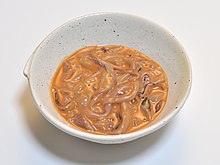
Shiokara (塩辛) lit. 'salty-spicy',[1] is a food in Japanese cuisine made from various marine animals that consists of small pieces of meat in a brown viscous paste of the animal's heavily salted, fermented viscera.[2]
The raw viscera are mixed with about 10% salt, 30% malted rice, packed in a closed container, and fermented for up to a month. Shiokara is sold in glass or plastic containers.
The flavor is similar in saltiness and fishiness to that of European cured anchovies, but with a different texture. One of the best-known chinmi ("rare tastes"),[3] it is quite strong and is considered something of an acquired taste even for the native Japanese palate.
It was a valuable protein in post-war Japan because food was scarce and it did not require refrigeration. It continued to be eaten as a condiment for rice and in bars.[1]
One method of enjoying it is to consume the serving in one gulp and to follow it with a shot of straight whisky. Some bars in Japan specialize in shiokara.
Some types of shiokara[edit]

- Ika no shiokara—from cuttlefish "squid", the most common variety
- Hotaruika no shiokara—from firefly squid
- Katsuo no shiokara—from skipjack tuna
- Kaki no shiokara—from oyster
- Uni no shiokara—from sea urchin roe
- Ami no shiokara—from Mysidacea, a krill-like crustacean
Some shiokara types have special names:
- ganzuke [ja] — from fiddler crab
- konowata — from sea cucumber
- mefun — from chum salmon
- uruka (shiokara) [ja] — from ayu
- shuto — from skipjack tuna (katsuo)
See also[edit]
- Dayok, a similar Filipino preparation
- Bekasang, a similar Indonesian preparation
- Anchovies as food
- Jeotgal
- Natto
References[edit]
- ^ a b Audrey Anderson. "Ocean Shock: Warming waters send squid out of reach in land of sushi". Reuters. Retrieved 2021-09-19.
- ^ Swinnerton, Robbie (2015-02-17). "Surugaya Kahei: a little shiokara goes a long way". The Japan Times. Retrieved 2021-09-19.
- ^ "Squid profits squeezed as Japan's catch hits record lows". The Japan Times. 2019-01-15. Retrieved 2021-09-19.

Well, that’s interesting to know that Psilotum nudum are known as whisk ferns. Psilotum nudum is the commoner species of the two. While the P. flaccidum is a rare species and is found in the tropical islands. Both the species are usually epiphytic in habit and grow upon tree ferns. These species may also be terrestrial and grow in humus or in the crevices of the rocks.
View the detailed Guide of Psilotum nudum: Detailed Study Of Psilotum Nudum (Whisk Fern), Classification, Anatomy, Reproduction